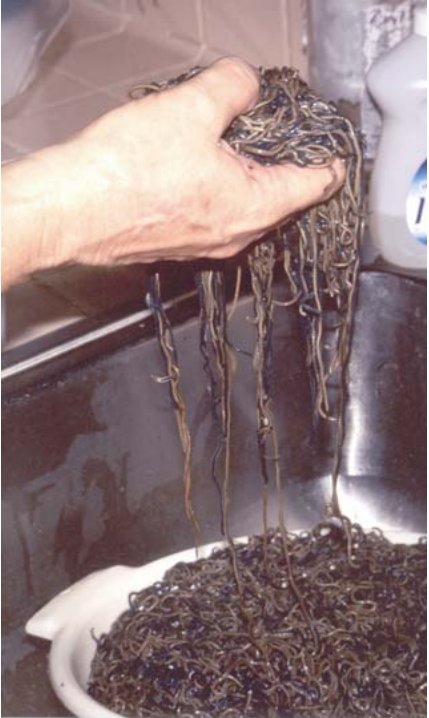Palolo worms must have one of the strangest life cycles in the animal kingdom, although there is plenty of competition. Driven by the cycles of the moon, the spindly worms split themselves into two separate parts. Their back ends, loaded with eggs and sperm, break off and swim to the ocean surface, while the rest of their bodies remain alive in the tropical coral reef.
The species of marine worm (Eunice viridis) is found around the coasts of some Pacific islands and parts of Southeast Asia where they dwell in the shallow waters near the coral reefs.
Not particularly known for their good looks, the creatures are slimy, segmented worms that measure up to 40 centimeters (about 16 inches) in length. They have a slight iridescent shine, meaning they glimmer with a variety of colors depending on the lighting, although they are generally reddish-brown or bluish-green depending on their sex.
Their peculiar reproductive behavior was first scientifically described in the 19th century, but it had been intimately known by the Indigenous people of the Samoan Islands for centuries. The worms’ behavior is so orderly that locals can predict the exact time and day when their backsides will emerge in the shallows – an event that’s patiently awaited and followed by a feast of the worms.

A handful of palolo worms.
Their reproduction is closely correlated with the time of year and lunar cycle, not too dissimilar to some other sea creatures. As explained by a study published in 1984, the event occurs during the third quarter of the moon shortly after midnight in October or November. This is springtime in the Southern Hemisphere, a period when the natural world is buzzing with new life.
“Because swarming coincides with the third quarter of the moon, it must occur 10 to 11 [days] earlier each year, until in some subsequent year, it must be postponed until the following third quarter, 29 to 30 [days] later,” the 1984 paper reads.
When the time comes, a part of the worm that’s filled with sperm and eggs (epitokous segment) will emerge at the water’s surface. These 20-centimeter (8-inch) long segments are broken open by the waves, filling with water with blue-green eggs, which intermingle with the released sperm and become fertilized. Meanwhile, the other part of the body (the atokous segment) remains in the reef and continues living.
The reason why the swarming is closely linked to the lunar phases is not perfectly clear, although there are some ideas that other external factors are at play. For instance, some corals will synchronize mass spawning events after a full moon once a year. Since coral provides the habitat for palolo worms, perhaps there’s a relationship between the two reproductive events.
Whatever the exact nature of the link, it’s apparent that the palolo worms use some cue that signals the reproductive process. In the wild west of the open sea, this synchronization maximizes the chances of fertilization, reproduction, and ultimately the survival of the species.
Source Link: Moon Cycles Drive The Wild Sex Life Of A Slimy Sea Creature In The Pacific